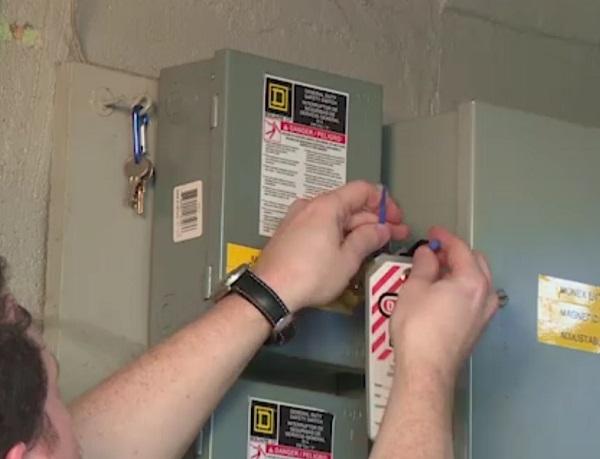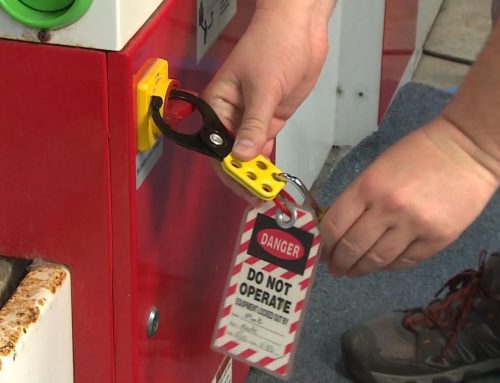Working with industrial machinery can be extremely dangerous, especially when maintenance or repairs need to be made. To prevent injuries and fatalities, OSHA has strict regulations regarding lockout/tagout procedures when servicing equipment. This comprehensive guide will provide an in-depth look at critical lockout/tagout protocols, special situations, rules for various equipment systems, and best practices for safety. The information presented is extracted from an online industrial safety training course. Proper implementation of lockout/tagout is essential for accident prevention and compliance.
Industrial Machinery Provides Productivity but Can Be Dangerous
Industrial machinery and powered equipment increase productivity exponentially, but the energy sources that drive these machines can also pose serious dangers to workers. Electrical, hydraulic, pneumatic, and other energy types enable heavy equipment to perform work humans cannot, but they also introduce hazards if not properly controlled. “Energy-related” injuries often occur when one worker services a machine while another unknowingly activates it. To prevent hazardous energy releases and accidental startups during maintenance, OSHA enacted lockout/tagout regulations describing isolation procedures.
Understanding the Purpose of Lockout/Tagout
The core purpose of lockout/tagout is straightforward – disable equipment from its power source while being serviced to prevent worker injuries. This involves isolating energy sources and placing locks, tags, and other mechanisms on the appropriate valves, switches, and isolation points. The “lockout” disables the machine from its power source, while “tagging” indicates work is in progress. Lockout/tagout should be utilized when:
- Repairing electrical circuits
- Lubricating or cleaning machinery
- Clearing jams
- Rebuilding equipment
- Performing setup/adjustment tasks
Required Components of a Lockout/Tagout Program
OSHA mandates that all facilities implement an “energy control program” to govern lockout/tagout procedures. This program must include:
- A written lockout/tagout program detailing isolation procedures for each piece of powered equipment.
- A training plan educating workers on energy control protocols.
Employers must provide the locks, tags, and accessories required by authorized workers to safely isolate energy sources. These devices must be identified as dedicated lockout/tagout equipment. Using improvised or non-OSHA compliant lockout/tagout materials can result in injuries or violations.
Equipment Isolation Devices and Tags
There are many types of devices used for equipment isolation including:
- Padlocks and chains
- Valve clamps
- Bolted blinds
- Wedges or pins
- Electro-mechanical interlocks
Tags indicate work in progress and supply warnings, but do not provide physical energy control. Tags should always be used with locks when possible for an added layer of protection. Tags must clearly identify the employee performing the work.
Worker Roles and Responsibilities
OSHA designates workers under lockout/tagout protocols as “authorized” or “affected”. Authorized employees install and remove lockout devices, service equipment, and assess energy sources. They must recognize all isolation points, energy types and magnitudes, and control methods for the equipment they lock out.
Affected employees normally operate machinery or work near it. They must understand the purpose of lockout/tagout and be notified when procedures are in use. Affected workers cannot restart locked out equipment.
Basic Lockout/Tagout Procedure Steps
When energy isolation is required, authorized employees should:
- Notify all affected workers.
- Shut down the machine at the point of operation.
- Isolate all energy sources by shutting off power at breakers, switches, or valves and installing lockout devices and tags.
- Dissipate any stored residual energy.
- Verify isolation by trying to restart the machine.
- Perform maintenance or servicing tasks.
Special Situations and Requirements
Certain scenarios call for expanded lockout/tagout procedures including:
- Group lockout when multiple workers service the same machine. This requires locks that accept multiple keys.
- Personnel changes between shifts. The incoming team must affix new locks before the previous shift’s locks are removed.
- Complex systems with multiple power sources. Consult supervisors before beginning lockout.
- Essential equipment needed for normal operation. Special protocols may allow temporary power restoration.
Additional measures for high voltage systems:
- Use properly insulated tools.
- Check for dangerous arc flash warning labels.
- Wear protective equipment like rated gloves.
Always follow employer procedures and consult supervisors if unsure how to handle special situations.
Returning Equipment to Service After Lockout
Strict procedures must also be followed when re-energizing equipment after service:
- Remove all tools and materials.
- Clear all workers from the area.
- Verify the machine is intact and ready for operation.
- Each employee removes their own lockout device.
- Test and re-start the equipment.
In emergencies, supervisors may remove devices if workers are unavailable. But they must be immediately informed afterwards.
Lockout/Tagout for Electrical Systems
Electrical lockout/tagout prevents the release of hazardous voltage and current to equipment. Follow these best practices:
- Identify and label all power sources. Use panel schedules.
- Shut off power at the machine first before disconnecting from sources.
- Stand to the side of panels and turn away when switching off circuits.
- Attach locks and tags at panels or boxes. Lock the ‘off’ not just the cover.
- Pulling fuses is not enough. The box must be locked too.
- Lockout main breaker boxes when possible if multiple power feeds exist.
- Use insulated voltmeters to verify de-energization after lockout.
- Ground stored power from capacitors.
Lockout/Tagout for Hydraulic & Pneumatic Systems
To control hazardous pressure in lines, valves and pumps should be locked and tagged out.
- Use valve clamps or chains to prevent valve reactivation.
- Install blinds to isolate sections of complex systems.
- Bleed and drain lines to remove stored pressure.
- Secure heavy parts and loads that could shift during service.
For pneumatic equipment, verify isolation by cracking valves downstream to check for pressure. Block out nearby traffic that could vibrate hydraulic/pneumatic machinery.
Conclusion
Implementing proper lockout/tagout procedures for industrial equipment is critical for avoiding injuries and accidents. Always follow your employer’s established energy control program closely and ask questions if anything is unclear. With training, vigilance and safe isolation practices, powered-equipment hazards can be effectively controlled. Use the information in this guide to reinforce your knowledge of vital lockout/tagout principles, rules, and procedures.



